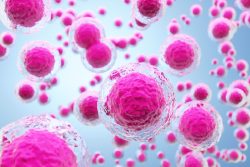Microplastics Found in Saliva After Chewing Gum
 You might want to add chewing gum to your list of unexpected microplastic sources. A new preliminary study reveals that just one piece can release up to thousands of microplastic particles directly into your saliva.
You might want to add chewing gum to your list of unexpected microplastic sources. A new preliminary study reveals that just one piece can release up to thousands of microplastic particles directly into your saliva.
Analysis showed that just one gram of chewing gum released an average of around 100 microplastic bits, and some samples releasing as many as 637 microparticles per gram. Since a single stick of gum often weighs between one and several grams, the total exposure could be significantly higher.
On average, someone who regularly chews gum could end up ingesting around 30,000 of the particles annually. The researchers set out to determine how much microplastic exposure might result from chewing both natural and synthetic gums. The researchers examined five different brands of synthetic gum and five varieties of natural gum.
The test consisted of one participant chewing each gum for four minutes, with researchers collecting saliva samples every 30 seconds using lab tubes. After chewing, the participant thoroughly rinsed their mouth several times with highly purified water. These rinses were then combined with the saliva samples to capture any remaining microplastics. The full process was repeated seven times for each gum variety.
Additionally, some gum samples were chewed for a full 20 minutes, with collection of the saliva every two minutes. This allowed researchers to assess how chewing duration affected the amount of microplastics released.
Interestingly, 94% of microplastics were emitted during the first eight minutes of chewing, suggesting most of the release happens early on. The researchers discovered that natural gums offered little advantage. On average, one gram of synthetic gum contained 104 microplastic particles, while natural gum wasn’t far behind, with 96 particles per gram.
To help limit microplastic exposure from gum, the researchers suggest chewing a single piece for a longer period rather than frequently switching to a new one. The study was only able to detect microplastics 20 micrometers or larger due to the limitations of the equipment and methods used. As a result, smaller particles, such as nanoplastics, may have gone undetected, highlighting the need for further research into the potential release of these tiny plastics during chewing.
To view the original scientific study click below:
Chewing gum can shed microplastics into saliva, pilot study finds



 The gut and brain communicate through a network known as the gut-brain axis. This is a system of physical and biochemical connections that allows them to influence each other’s function and overall health. Emerging research indicates that regularly consuming vegetable oils may negatively impact both gut and brain health. The word “vegetable” on a label often signals something healthy, but that’s not always the case with oils and fats.
The gut and brain communicate through a network known as the gut-brain axis. This is a system of physical and biochemical connections that allows them to influence each other’s function and overall health. Emerging research indicates that regularly consuming vegetable oils may negatively impact both gut and brain health. The word “vegetable” on a label often signals something healthy, but that’s not always the case with oils and fats. Stem cells impact the immune system in various ways, influencing tissue repair, modulating immune responses, and affecting the progression of certain diseases, both directly and indirectly. Blood is composed of various cell types that evolve from a common precursor, the blood stem cell. A research team has recently explored the developmental pathways of human blood cells and have found surface proteins that help them inhibit the activation of inflammatory and immune responses within the body.
Stem cells impact the immune system in various ways, influencing tissue repair, modulating immune responses, and affecting the progression of certain diseases, both directly and indirectly. Blood is composed of various cell types that evolve from a common precursor, the blood stem cell. A research team has recently explored the developmental pathways of human blood cells and have found surface proteins that help them inhibit the activation of inflammatory and immune responses within the body. Tinnitus is the sensation of hearing noise when no external sound is present. This often includes ringing, buzzing, or other phantom sounds in the ears or head, and, in most cases, it’s a personal experience, only the person affected can hear it. Turns out what you eat might help with tinnitus. Recent research shows that healthy foods like fruits and fiber-rich meals could actually cut down your risk.
Tinnitus is the sensation of hearing noise when no external sound is present. This often includes ringing, buzzing, or other phantom sounds in the ears or head, and, in most cases, it’s a personal experience, only the person affected can hear it. Turns out what you eat might help with tinnitus. Recent research shows that healthy foods like fruits and fiber-rich meals could actually cut down your risk. A recent study revealed that adopting an anti-inflammatory diet, which includes whole grains, vegetables and fruits, and reducing consumption of red and processed meats as well as ultra-processed foods like sodas, sugary cereals, fries, and ice cream, can decrease the risk of dementia by 31%. Learning to differentiate between foods that cause inflammation and those that combat it could help lower the likelihood of the onset of dementia.
A recent study revealed that adopting an anti-inflammatory diet, which includes whole grains, vegetables and fruits, and reducing consumption of red and processed meats as well as ultra-processed foods like sodas, sugary cereals, fries, and ice cream, can decrease the risk of dementia by 31%. Learning to differentiate between foods that cause inflammation and those that combat it could help lower the likelihood of the onset of dementia. Dementia is a growing global health challenge that takes a significant toll on both individuals and society. With no cure yet available, finding ways to slow its progression or reduce the risk of developing it is critical for supporting healthy aging. Now, new research points to weight training as a potential way to help protect the brain from dementia.
Dementia is a growing global health challenge that takes a significant toll on both individuals and society. With no cure yet available, finding ways to slow its progression or reduce the risk of developing it is critical for supporting healthy aging. Now, new research points to weight training as a potential way to help protect the brain from dementia. With worldwide population growing older, identifying dietary patterns that not only prevent chronic diseases but also effectively support healthy aging becomes increasingly important. Researchers define healthy aging as the ability to reach the age of 70 without major chronic illnesses, and with maintained cognitive, physical, and mental well-being.
With worldwide population growing older, identifying dietary patterns that not only prevent chronic diseases but also effectively support healthy aging becomes increasingly important. Researchers define healthy aging as the ability to reach the age of 70 without major chronic illnesses, and with maintained cognitive, physical, and mental well-being.  Receptors typically associated with detecting flavors on the tongue have been identified in areas of the body, including the intestines, stomach, airways, and pancreas. A recent study has found that when these taste receptors are activated by sweet substances, they can significantly influence the contraction of heart muscles.
Receptors typically associated with detecting flavors on the tongue have been identified in areas of the body, including the intestines, stomach, airways, and pancreas. A recent study has found that when these taste receptors are activated by sweet substances, they can significantly influence the contraction of heart muscles. Adequate sleep is vital for maintaining good health, equally as important as a nutritious diet and consistent exercise. It enhances cognitive function, elevates mood, and promotes overall wellness. A lack of sufficient, high-quality sleep on a regular basis can lead to an increased risk of several serious health conditions, including stroke, heart disease, dementia, and obesity.
Adequate sleep is vital for maintaining good health, equally as important as a nutritious diet and consistent exercise. It enhances cognitive function, elevates mood, and promotes overall wellness. A lack of sufficient, high-quality sleep on a regular basis can lead to an increased risk of several serious health conditions, including stroke, heart disease, dementia, and obesity. Lung cancer has not typically been considered linked to diet. Yet, recent research has revealed an unexpected factor contributing to lung cancer risk. The mix of sugar and fat in our diets. A diet high in sugar and fat could cause glycogen, a form of stored sugar, to build up in lung tissues. Researchers believe this buildup could potentially set the stage for cancer development.
Lung cancer has not typically been considered linked to diet. Yet, recent research has revealed an unexpected factor contributing to lung cancer risk. The mix of sugar and fat in our diets. A diet high in sugar and fat could cause glycogen, a form of stored sugar, to build up in lung tissues. Researchers believe this buildup could potentially set the stage for cancer development.